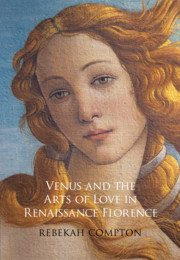Book contents
- Venus and the Arts of Love in Renaissance Florence
- Venus and the Arts of Love in Renaissance Florence
- Copyright page
- Dedication
- Contents
- Figures
- Acknowledgments
- Introduction
- One Golden Splendor
- Two Cultivating Complexions
- Three Sartorial Seduction
- Four Green Gardens
- Five Erotic Anatomy
- Six Maritime Treasures
- Conclusion
- Bibliography
- Index
Conclusion
Attendant Pleasures
Published online by Cambridge University Press: 04 March 2021
- Venus and the Arts of Love in Renaissance Florence
- Venus and the Arts of Love in Renaissance Florence
- Copyright page
- Dedication
- Contents
- Figures
- Acknowledgments
- Introduction
- One Golden Splendor
- Two Cultivating Complexions
- Three Sartorial Seduction
- Four Green Gardens
- Five Erotic Anatomy
- Six Maritime Treasures
- Conclusion
- Bibliography
- Index
Summary
Venus and the Arts of Love has examined Venus in Renaissance Florence, focusing on the goddess’s portrayal in paintings, sculptures, and the decorative arts between 1300 and 1600. Venus first entered Tuscan literature and art as an astrological deity, attracting lovers and patrons alike with her scintillating splendor. From the heavens, she descended to earth. Au naturel or fashionably dressed, she entered the spaces where men and women dressed, undressed, bathed, and engaged in procreative intercourse. Her clear complexion, rosy cheeks, and pink lips encouraged women to cultivate and care for their skin, while simultaneously reinforcing their duty to join their flesh with that of another to produce new flesh. Draped in white and red silks and girded with her magical cestus, the goddess also modeled Florence’s fashionable silks, reminding her devotees of the enchanting power of clothing and adornment and challenging artists to render them in vibrant colors. Indeed, the correspondences between Venus’ celestial likeness and her earthly materials stimulated painterly innovations in media and technique. Her be-flowered and fruitful gardens, which reveal developments in naturalism, introduced verdancy into the domestic interior. Green places were not only amorous but also therapeutic, since the color could soothe the eyes and transfer a salubrious spirit, via the sense of sight, to the body, mind, and spirit.
- Type
- Chapter
- Information
- Venus and the Arts of Love in Renaissance Florence , pp. 242 - 246Publisher: Cambridge University PressPrint publication year: 2021



